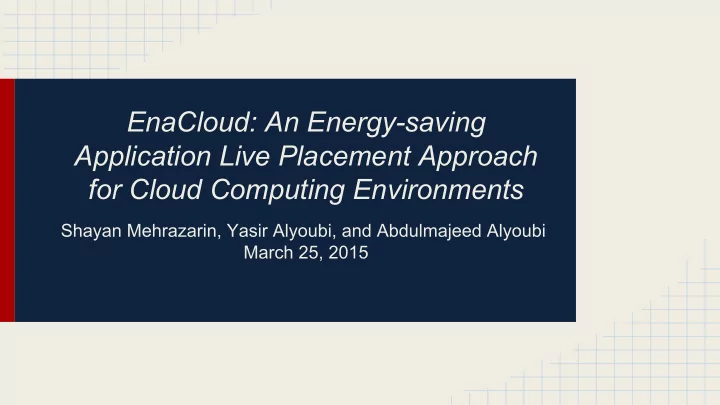

EnaCloud: An Energy-saving Application Live Placement Approach for Cloud Computing Environments Shayan Mehrazarin, Yasir Alyoubi, and Abdulmajeed Alyoubi March 25, 2015
Outline ● The Objective of EnaCloud ● The Contributions of EnaCloud ● The Methodology of EnaCloud ● Example of How EnaCloud Works ● Energy-Aware Heuristic Algorithm ● Interpretation of the Results
The Objective of EnaCloud ● Various solutions have been proposed in the past to address problems of high energy consumption, but there are some issues that have not been properly addressed: ○ Some methods of energy savings, such as turning off the monitor or enabling sleep mode, benefit only a single computer but not the whole cloud platform ○ Releasing some server nodes in large data centers and turning them off (“workloads concentration”) requires static configurations & settings ■ In open clouds, applications dynamically arrive & depart ○ These solutions require applications to be able to shut down and then copy them to idle servers ■ However, underutilization of the server is likely as it does not support live application migration
The Contributions of EnaCloud ● Major contributions of EnaCloud towards previously proposed solutions: ○ Introduction of an energy-conscious algorithm to gather application schemes with regards to various events that occur (arrival, departure) ○ Designing and implementing an architecture for EnaCloud that is based on a virtual computing environment that works with HaaS ( Hardware-as-a-Service ) and SaaS ( Software-as-a-Service ) cloud services ■ This approach can reduce energy-consumption based on experiments and studies
The Methodology of EnaCloud ● For the purpose of EnaCloud, the authors assume: ○ All computing nodes are similar ○ Each server has a resource capacity of 1 unit ○ All nodes are connected to each other via LAN ( high speed ) ○ Each computing node contains ≥ 1 virtual machine (VM) ● Additionally, the authors classify nodes as: ○ open box for active server nodes using VM ○ closed box for inactive server nodes not using VM
The Methodology of EnaCloud (cont.) ● EnaCloud ensures workloads are calculated in a way that minimizes the amount of open boxes ○ Workloads will always depart or arrive dynamically in a typical cloud service ● Over-precision ratio defined as α ≥ 0 and α ≤ 1 for energy-aware heuristic algorithm ○ used to check if size’(x) falls between (1 - α) * size(x) and (1 + α) * size(x)
Example of How EnaCloud Works ● Suppose in this example that there is the arrival of a 0.5 unit workload ○ A new box should be opened ○ However, it is possible to avoid opening a close box if this workload can be placed into the first node (out of 2 nodes) ■ It would be required to migrate the first node to the second node
Example of How EnaCloud Works (cont.) a) Without migration - Inserting a new workload requires three open boxes b) With migration - Inserting a new workload while maintaining two open boxes
Example of How EnaCloud Works (cont.) ● Workload resizing is the event where applications will have resource demands that vary ● Workload resizing includes: ○ workload inflation , which impacts the other workloads’ performance within the same node ○ workload deflation , which frees some resources and can result in wasting energy along with idling of resources
Example of How EnaCloud Works (cont.) ● A common problem is using migration to re-map workloads alongside resource nodes with the arrival, departure, or resizing of workloads ● There are two goals with migration: ○ to keep the amount of open boxes at a minimum ○ to keep migration times at a minimum
Energy-Aware Heuristic Algorithm ● It is based on partitioning workload size from (0, 1] into 2*M - 2 subintervals: L 0 = ( (M - 1) / M, 1 ] L 1 = ( (M - 2) / (M - 1), (M - 1) / M ] . . . L M-1 = ( 1/3, 1/2 ] . . . L 2*M-4 = ( 1 / M, 1 / (M - 1) ] L 2*M-3 = ( 0, 1 / M ]
Energy-Aware Heuristic Algorithm (cont.) ● Pseudo-code for workload arrival function is shown on the right ● Includes implementation for First- Fit and Best-Fit too
Energy-Aware Heuristic Algorithm (cont.) ● The workload departure function is shown below in pseudo-code: ● The workload resize function is shown below, as well:
Interpretation of the Results - Nodes ● With regards to the amount of active nodes, the authors demonstrate using a chart ( shown on the right ) how EnaCloud compares with First Fit and Best Fit data ● We interpreted from the chart that EnaCloud maintains a decent balance between the increase and decline of active nodes over a period of approximately 500 to 600 minutes ● Amount of active nodes can range based on experiments from 20 to 40 active nodes Number of Active Nodes vs. time (minutes)
Interpretation of the Results - Energy ● The authors demonstrate using a chart ( shown on the right ) how EnaCloud compares with First Fit and Best Fit data with regards to how much energy is consumed ● Based on our interpretation of the experiment results, it seems that EnaCloud indeed has an energy savings as more time has elapsed ● However, it would not have too much savings for short periods of time Energy (kWh) vs. time (minutes)
Interpretation of the Results - Utilization ● The authors show using a chart ( shown on the right ) how EnaCloud compares with First Fit and Best Fit data with regards to the percentage of pool utilization ● Our interpretation of the data suggests that the utilization rate tends to be consistent for the most part with EnaCloud ● Ranges between 80 to 95 percent Pool Utilization (%) vs. time (minutes)
Any Questions?
Recommend
More recommend